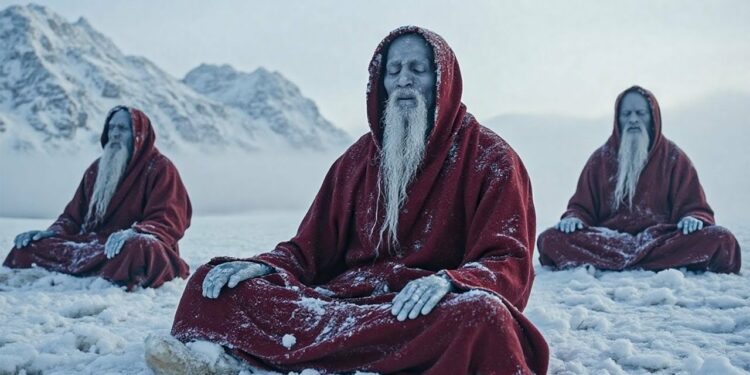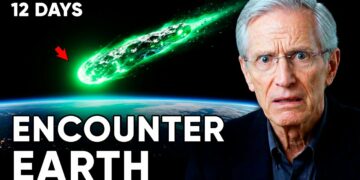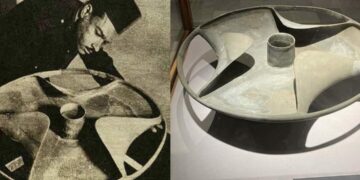We cannot measure the minds of monks, but their extraordinary feats—from defying gravity to embarking on spiritual quests—showcase their ability to push the boundaries of human potential. For centuries, monks have demonstrated superhuman endurance and unshakable discipline. What is their secret? What fuels their remarkable abilities? Today, we explore the mysterious world of monks and uncover the astonishing stories behind their legendary powers.
The Monk in the Snow
In the harsh, uninhabitable heights of China’s Tibet, where life struggles to survive, a lone monk resides at Rangjung Monastery, the highest monastery on Earth. Surrounded by an endless white void and piercing winds, he sits in silence without fire or shelter. His name is unknown, and no one tracks the days he has spent there. Every morning, before the first light touches the Himalayan peaks, he performs a ritual that would break most people in minutes. With no fire to ward off the brutal cold, he scoops snow with bare hands, pressing it against his skin—not as a test or punishment, but as an act of surrender. His only drinking water comes from the ice he melts with his body heat, sipping it slowly as if it carries something sacred.
This monk has forsaken not only warmth but also food. While most would crumble at the thought of skipping a meal, he draws strength from mastery of the mind. For hours, he sits perfectly still, chanting sacred mantras that fill the air with an unseen presence. His greatest act, however, is letting go. To him, this mountain is a temple, a sacred space where he seeks to dissolve his identity and merge with the divine presence of Shiva, the cosmic force of destruction and transformation.
The Gravity-Defying Monk
While one monk surrenders to the brutal cold, another defies gravity itself. In 2020, a video surfaced on X that left viewers stunned. A woman, equipped with ropes and a safety harness, climbed a near-vertical mountain with intense focus. Beside her, a barefoot monk, without any climbing gear, ascended the rock face as if strolling casually. Shared by Tansu Yegen, the clip garnered over 510,000 views and 22,000 likes. Comments flooded in, attributing his seemingly impossible ascent to yoga, meditation, and years of discipline. Some called it the ultimate display of clumsiness versus expertise, while others noted his technique—moving side to side to lessen the steepness—proving mastery is about wisdom, not just strength.
How can a human body defy gravity like this? The secret lies in mental control. Through relentless training, the monk has conditioned his mind to remain calm in the face of danger. His breath stays steady, his heart rate low, his muscles relaxed, and his grip unshaken. Fear does not exist in his world, allowing him to climb with bare hands and unwavering focus.
The Karmapa: A Living Legacy
The Karmapa is not just a leader but a force of nature, carrying the spiritual weight of countless lifetimes as the head of the Karmak Kagyu lineage. When one Karmapa passes, the search for his reincarnation begins—not through politics, but through visions, sacred texts, and mystical signs. In June 1985, in the rugged landscapes of Tibet, a boy named Apo Gaga was born to a nomadic family. His birth was marked by extraordinary signs: his mother dreamt of divine beings, a cuckoo perched on their tent, and an unearthly sound echoed through the valley. At age four, he began his monastic education, but at seven, he made a startling announcement: his family must move to another valley. Days later, lamas arrived, guided by a prophecy from the 16th Karmapa, confirming Apo Gaga as the 17th Karmapa, Ogyen Trinley Dorje. His identity was affirmed by the 14th Dalai Lama and even the Chinese government.
Central to this lineage is the Black Hat Ceremony, where the Karmapa dons a headdress said to be woven from the hair of celestial beings. This ritual, steeped in legend, amplifies his divine presence. Devotees describe an undeniable energy during the ceremony, bridging the physical and sacred. Today, the Karmapa blends ancient wisdom with modern calls for action on climate change, education, and global harmony, embodying enlightenment as a living force.
Liuquan: The Self-Mummified Monk
In 2015, researchers examining an ancient Buddha statue in Budapest’s National Museum of Natural History uncovered a shocking secret: the mummified remains of Buddhist Master Liuquan, perfectly preserved inside. Liuquan had undergone self-mummification, a grueling process where monks prepare their bodies for preservation while alive. For years, he survived on nuts, seeds, bark, and roots, eliminating fat and moisture. He drank toxic tree sap to ward off bacteria and decay. In his final act, Liuquan sealed himself in a stone chamber, meditating until his death. When the bell he rang daily fell silent, his fellow monks waited years before opening the chamber. Inside, they found his body perfectly preserved, a testament to his enlightenment.
Cryptic symbols and inscriptions surrounded him, believed to hold lost meditation techniques and esoteric teachings. Liuquan’s path demanded the ultimate price: his own life, proving that some monks push devotion to unimaginable extremes.
Honen: The People’s Monk
In 12th-century Japan, enlightenment was reserved for elite monks who studied sacred texts in isolated temples. Honen, born in 1133, mastered Tendai Buddhism but saw its exclusivity as a barrier. He discovered Pure Land Buddhism, which taught that salvation was a gift accessible to all through a single chant: “Namu Amida Butsu.” This radical idea gave hope to farmers and outcasts, challenging the Buddhist establishment. In 1207, Honen was declared a threat, his followers hunted, and he was banished. Yet his message endured, founding the Jodo school, one of Japan’s most practiced traditions today.
Luang Pho Daeng: The Eternal Monk
At Wat Kunaram Temple in Thailand, Luang Pho Daeng’s body remains untouched by decay since his death in 1973. Seated in meditation, his serene expression defies time. His plant-based diet and disciplined lifestyle may have contributed, but many believe his mastery of mind and body transcended natural laws. Tourists and devotees marvel at the monk who seems to have paused death itself.
Bodhidharma: The Spiritual Warrior
Bodhidharma, a 6th-century monk, sat in meditation for nine unbroken years, staring at a cave wall. His fierce dedication birthed Shaolin Kung Fu, blending physical training with spiritual focus to strengthen monks’ bodies and minds. His teachings reshaped Chinese Buddhism and influenced global Zen practices, proving that true wisdom comes from direct experience, not scriptures.
Marpa Lotsawa: The Great Translator
In 11th-century Tibet, Marpa Lotsawa braved perilous Himalayan journeys to bring Indian Buddhist teachings to Tibet. His translations, infused with lived wisdom, laid the foundation for Tibetan Buddhism. His mentorship of Milarepa, whom he purified through grueling trials, produced Tibet’s revered poet-saint, ensuring the survival of their spiritual legacy.
Sri Ramakrishna: The Universal Mystic
Born in 1836 near Kolkata, Sri Ramakrishna’s intense devotion dissolved boundaries between himself and the divine. He explored Christianity and Islam, realizing all religions share the same essence. His disciple, Swami Vivekananda, spread his teachings globally through the Ramakrishna Mission, building schools and hospitals that embody his vision of universal truth.
The 200-Year-Old Mummified Monk
In Mongolia, a 200-year-old mummified monk was discovered in deep meditation, his body nearly untouched by time. Some believe he practiced tukdam, a meditative state where consciousness lingers after physical death. Mongolia’s cold may have helped, but his disciplined lifestyle likely altered his body’s chemistry, defying decay for centuries.
Xu Yun: The Unshakable Sage
Born in 1840, Xu Yun endured wars, political upheaval, and torture during China’s Communist crackdown. Through it all, he restored monasteries like Yunmen and spread Chan Buddhism’s emphasis on direct experience. His teachings influenced global Zen practices, proving wisdom withstands time and oppression.
Lama Tsongkhapa: The Living Buddha
In the 15th century, Lama Tsongkhapa meditated into eternity to protect his village, his body naturally mummified. Unearthed in 1975 after an earthquake, his perfectly preserved remains confirmed his enduring spiritual presence, a silent guardian transcending life and death.
St. Anthony the Great: The Desert Warrior
Born in 251 AD, St. Anthony renounced wealth to live in Egypt’s desert, battling spiritual demons with prayer and faith. His solitary quest inspired Christian monasticism, showing that deep solitude brings divine connection. His 106-year life became a model for simplicity and self-denial.























